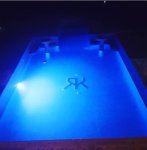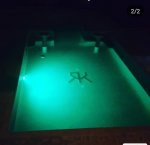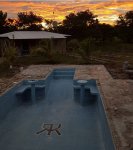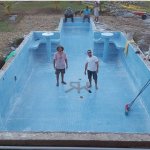I'm a new partial owner of a hostel in Nicaragua. Having swam in the pool prior to purchasing the property, I noticed that when very near to the pool light (6 inches to a foot), a mild and constant electrical shock could be felt. I only felt this at night when the light was powered on, but neglected to check and see if the same thing occurred with the light off during the day (I wont be back to the property until next year). Photos of the pool can be seen below. There is only 1 light installed. The photos I have attached are the only photos I could get showing the construction of the pool, and I'm not sure if it was properly bonded (I would assume it is not, since a mild continuous shock can be felt.....and it was constructed on the cheap in Nicaragua). I also do not see any rebar in the photo before the deck was installed. The people I purchased from couldn't answer many questions, as they aren't entirely sure about the specifics of the construction methods and are not knowledgeable with regards to pool bonding/pool electrical issues.
My question is, If I were to replace the light with a plastic ringed LED (rather than the present metal ringed one) would that alleviate the problem? Testing for proper bonding in Nicaragua will be a daunting task and parts are hard to come by there, so I would purchase a new light in the states and fly it down there with me on my next trip and install it myself. Would eliminating the light fixture all together be a better idea? E.g. cement plug and tile over the current light housing area? How unsafe would the pool be if proper bonding is not done?
Also, is there any way to ensure the pool is properly bonded without tearing up the entire deck surrounding the pool? I fear I may need to fly an electrician friend down to inspect everything before proceeding, but figured I would inquire here with you guys first, as there seems to be quite a few very knowledgeable people on this forum.
Thanks in advance for the help and my apologies for the low resolution photos, but they were all that was available.
cerF
My question is, If I were to replace the light with a plastic ringed LED (rather than the present metal ringed one) would that alleviate the problem? Testing for proper bonding in Nicaragua will be a daunting task and parts are hard to come by there, so I would purchase a new light in the states and fly it down there with me on my next trip and install it myself. Would eliminating the light fixture all together be a better idea? E.g. cement plug and tile over the current light housing area? How unsafe would the pool be if proper bonding is not done?
Also, is there any way to ensure the pool is properly bonded without tearing up the entire deck surrounding the pool? I fear I may need to fly an electrician friend down to inspect everything before proceeding, but figured I would inquire here with you guys first, as there seems to be quite a few very knowledgeable people on this forum.
Thanks in advance for the help and my apologies for the low resolution photos, but they were all that was available.
cerF
Attachments
Last edited:





